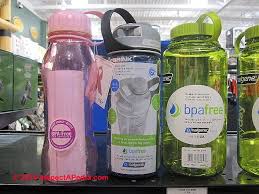Bisphenol A, a Major Health Hazard

Bisphenol A (BPA) is a carbon based synthetic compound belonging to the group of diphyenylmethane derivatives and bisphenols with two hydroxyphenyl groups. It is a colorless solid soluble in organic solvents. BPA is employed to make certain plastics and epoxy resins. It is used to make a variety of consumer goods such as water bottles, dental sealants, CDs and DVDs. Epoxy resins containing BPA are used to line water pipes, as coating on the inside of many food beverage cans and in making special fine paper used in sales receipts.
More than 90% of people have BPA in their bodies. They get it mainly by eating foods that have been in containers made with BPA. It's also possible to pick up BPA through air, dust, and water.
The researchers have shown that BPA lingers in the body fat at high levels for much longer even after fasting for 24 hours. This suggests that BPA doesn’t metabolize rapidly because it comes from non-food sources. The researches have found in a study that 95% of adult human urine samples and 93% of samples in children had bisphenol A. It has been found that babies absorb a lot of BPA who are fed by polycarbonate bottles.
The extensive exposure of people to BPA has been found to cause many health hazards, which have been enumerated below.
- Affects egg maturation in humans - A study published recently online in the journal Human Reproduction is the first of its kind to show the direct effects of BPA on egg maturation in humans. The eggs of subjects were exposed to varying levels of BPA in the laboratory. After being exposed to BPA, on examination of eggs it was found that the percentage of eggs that matured decreased and the eggs that matured did not have bipolar spindles and aligned chromosomes as unaffected eggs do. Moreover, exposure to BPA may affect the quality of women’s eggs retrieved for in vitro fertilization (IVF).
- Increases risk of erectile dysfunction - A new study of over 600 workers in China suggests that workplace exposure to BPA is linked to increased risk of erectile dysfunction and other male sexual problems such as difficulty ejaculating and sexual desire. The BPA levels, these men were exposed to, were 50 times higher than that experienced by the average American male in the US.
- Causes testicular cancer - Exposure to BPA has also been found to cause a reduction in the production of sperms and an increase in the incidence of testicular cancer in adults.
- Increases risk of heart disease – The researchers have found evidence linking BPA to heart disease in adults.
- Increases risk of diabetes – Studies have shown that high level of BPA in the body is linked to insulin resistance and type-2 diabetes. It has been found that persons with the highest BPA levels are more than twice as likely to have heart disease and/or diabetes, compared to the persons with the lowest BPA levels.
- Increases obesity – In animal experiments, rats and mice exposed to higher doses of BPA developed obesity. Some scientists believe that BPA can disrupt the function of the hormones, especially estrogen. But this biological effect is far from clear in humans.
- Affects sex hormones in men – The researchers have found that higher BPA exposure was statistically associated with endocrine changes in men, specifically small increases in levels of testosterone in the blood.
- Affects brain function – The researchers have discovered that it caused loss of connections between brain cells in primates and may lead to disruption in memory and learning as well as depression. Apart from its presence in the ovaries, estrogen is also found in the brain, where it contributes to the development and working of the hippocampus and prefrontal cortex, two parts of the brain that regulate mood and help form memories. Thus, BPA prevents the response of the synapses in the brain to the estradiol in hippocampus and prefrontal cortex of non human primates, whose ovaries have been removed.
- Increases risk of breast cancer – The researchers have concluded that exposure in the womb to chemicals like BPA can increase an offspring's risk of breast cancer. BPA is a weak estrogen and has a profound effect on gene expression in breast throughout life. In view of this potential risk, the endocrine disrupters like BPA may be considered as a potential cause for the development of breast lesions in adults.
- Increases asthma – New research has found a link between increasing asthma rates and a particular threshold of BPA. In the study, maternal exposure to 10 micro g/ml of BPA in mice enhanced the allergic sensitization and bronchial inflammation. and responsiveness in their pups. This dosage mimics the human BPA burden of chronic exposure, including that of pregnant women.
- Reduces the efficacy of chemotherapy treatments - BPA acts in cancer cells similar to the way estrogen does, by inducing proteins that protect the cells from chemotherapy agents. Estrogen's protein-inducing action has been previously linked to chemotherapy resistance but researchers have been unable to explain why such resistance still occurs in certain patients with less estrogen.
How to avoid exposure to BPA -
It is difficult to avoid BPA because it is so prevalent in the environment. We can minimize its exposure by:
- checking for a BPA-free label on foods and packaging
- buying and storing foods in glass jars, not plastic
- using fresh, frozen, or dried products instead of canned ones
- avoiding microwaving foods in plastic containers
- not washing plastic containers in the dishwasher or use harsh detergents on them
- choosing wooden toys instead of plastic ones
- breastfeeding infants as far as possible instead of bottle feeding
The bottom line -
The worldwide use of things containing BPA is ever increasing, although many countries have legally introduced legislations to control its use. The worldwide BPA production has now reached more 7 billion pounds per year. So, eliminating direct exposures from its use in food and beverage containers will prove far easier than finding solutions for the massive worldwide contamination by this chemical. But, in spite of legislations for the regulation of the use of things containing BPA, there is an urgent need of the hour to spread awareness among people about its potential hazards to the public heath.







